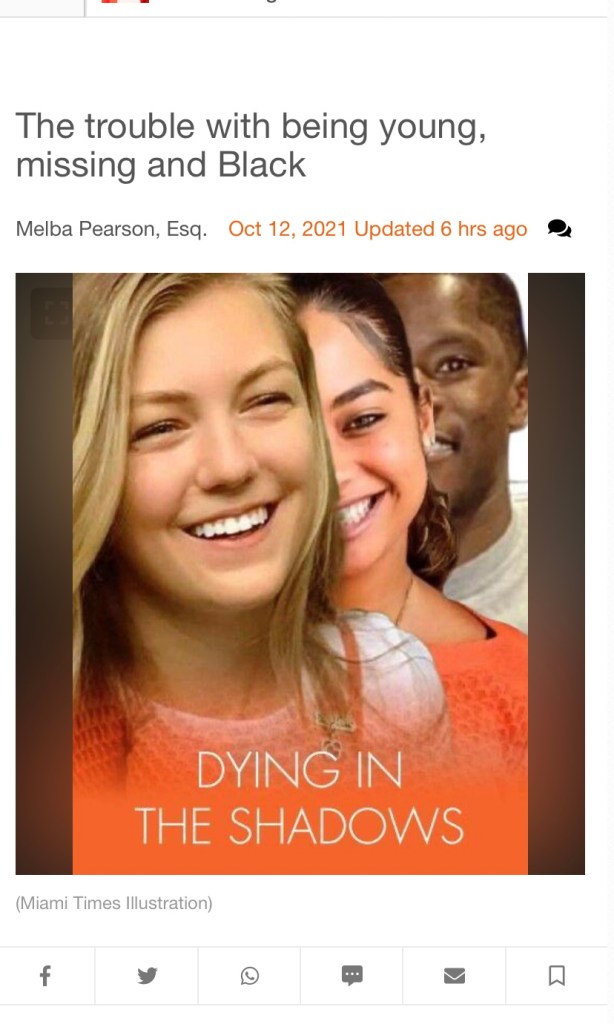
This story originally appeared in the Miami Times on October 12. Check out my thoughts!
Everyone has heard the tragic story of Gabby Petito. It captivated headlines and news reports for weeks on end, chronicling the search, the desperate pleas from her family and the eventual discovery of her remains. Televisions and every portable device blasted her picture. As one can imagine, this led to an outpouring of tips that led law enforcement to where Gabby was eventually found.
During that same time, two other young people went missing and two other families were searching for their loved ones. Miya Marcano (Florida) and Jelani “JJ” Day (Illinois) were both young people of color. They were both students. They had their futures ahead of them, were bright and loved by their families. Yet their stories did not get the same traction or attention.
Why does this happen? First, it has to do with the respect for Black lives in this country. Unfortunately, biases remain when it comes to law enforcement as well as those who are decision-makers in newsrooms.
When it comes to the media, these cases really underscore the importance of having people of color in positions of power in newsrooms, editorial boards and anywhere news is being made. Many times, a story will hit someone to the core, because they identify with the people involved. Unfortunately, if newsrooms are predominately white, the stories that will resonate would be ones that remind them of their cousin, sister, brother or another loved one – people who will likely look like them. By default, Black stories get left out of the mix. If there are more reporters of color, then stories that resonate with people of color will also rise to the forefront, along with cultural sensitivity in the storytelling.
The other issue is law enforcement. This is not to say that police deliberately look at someone and say “This is a person of color, therefore we are not going to look for them.” However, due to biases based in stereotypes, there can be a belief that the person was a runaway even though they had no prior history of doing so. They could feel that since the missing person was battling addiction, or engaged in sex work or other risky lifestyles, they are not worthy of the same amount of attention and resources as someone who is a soccer mom. And that issue of not relating in the same way to a missing person of a different race, while not necessarily intentional, comes into play as an unconscious bias. This is why diversity in law enforcement is incredibly important as well.
For instance, it has come to light that in the initial stages of Miya Marcano being reported as missing, a responding deputy laughed and stated “this is not a high-priority case.” His statement shows not only a lack of sensitivity, but reveals the deeper issues that delayed Miya being found sooner. In the case of Jelani Day, the FBI only recently got involved after a month of him being missing. The family is upset that this is being approached as a suicide rather than as potential foul play. While more has yet to be revealed around his cause of death, his family is adamant that Jelani was in good spirits and showed no signs of distress.
Lastly, there is the issue of shifting blame to the victim. While there is an outpouring of sensitivity around Gabby staying in an abusive relationship, and people trying to figure out when the signs were missed or if earlier intervention could have saved her life, reporting around Miya has much to do with her rejecting the advances of a local man. The local man, who did maintenance for her apartment building, committed suicide and remains a person of interest in her death.
The fact that the focus is on her saying “no” rather than him stalking her, refusing to respect her wishes, breaking into her home and eventually (allegedly) killing her, is problematic. Shifting the focus away from his actions is giving a potential killer a pass, and also furthering the narrative that women do not get the right to say no. Their bodies, who they engage with, and how and when, is not within their control. This is not the lesson we want our young people to learn. We must also teach our kids that no means no. If someone tells you no, accept it for what it is and move on. Don’t be afraid to say no to anyone. No should never cost you your life.
Moving forward, it is incredibly important for all of us to support diverse news sources, as well as support organizations like NABJ & NAHJ to ensure that writers of color can thrive, and rise to the ranks in order to be in decision making positions. We need to follow, support and share the stories that are written by diverse authors, again, so that with the increase in their readership, their ability to be heard in rooms where decisions are made also increase.
Diversity in law enforcement continues to be a major issue that touches so many aspects of criminal justice. We need to continue that fight and support those who are looking to change the profession by eliminating bias.
Lastly, we must empower our young people to say no, accept no, and protect each other as much as possible.

Insightful blog. Thanks for sharing!